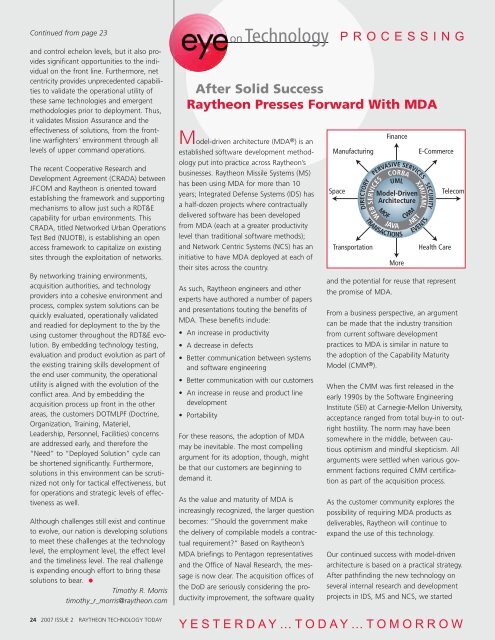2007 Issue 2 - Raytheon
2007 Issue 2 - Raytheon
2007 Issue 2 - Raytheon
Create successful ePaper yourself
Turn your PDF publications into a flip-book with our unique Google optimized e-Paper software.
Continued from page 23<br />
and control echelon levels, but it also provides<br />
significant opportunities to the individual<br />
on the front line. Furthermore, net<br />
centricity provides unprecedented capabilities<br />
to validate the operational utility of<br />
these same technologies and emergent<br />
methodologies prior to deployment. Thus,<br />
it validates Mission Assurance and the<br />
effectiveness of solutions, from the frontline<br />
warfighters’ environment through all<br />
levels of upper command operations.<br />
The recent Cooperative Research and<br />
Development Agreement (CRADA) between<br />
JFCOM and <strong>Raytheon</strong> is oriented toward<br />
establishing the framework and supporting<br />
mechanisms to allow just such a RDT&E<br />
capability for urban environments. This<br />
CRADA, titled Networked Urban Operations<br />
Test Bed (NUOTB), is establishing an open<br />
access framework to capitalize on existing<br />
sites through the exploitation of networks.<br />
By networking training environments,<br />
acquisition authorities, and technology<br />
providers into a cohesive environment and<br />
process, complex system solutions can be<br />
quickly evaluated, operationally validated<br />
and readied for deployment to the by the<br />
using customer throughout the RDT&E evolution.<br />
By embedding technology testing,<br />
evaluation and product evolution as part of<br />
the existing training skills development of<br />
the end user community, the operational<br />
utility is aligned with the evolution of the<br />
conflict area. And by embedding the<br />
acquisition process up front in the other<br />
areas, the customers DOTMLPF (Doctrine,<br />
Organization, Training, Materiel,<br />
Leadership, Personnel, Facilities) concerns<br />
are addressed early, and therefore the<br />
“Need” to “Deployed Solution” cycle can<br />
be shortened significantly. Furthermore,<br />
solutions in this environment can be scrutinized<br />
not only for tactical effectiveness, but<br />
for operations and strategic levels of effectiveness<br />
as well.<br />
Although challenges still exist and continue<br />
to evolve, our nation is developing solutions<br />
to meet these challenges at the technology<br />
level, the employment level, the effect level<br />
and the timeliness level. The real challenge<br />
is expending enough effort to bring these<br />
solutions to bear. •<br />
Timothy R. Morris<br />
timothy_r_morris@raytheon.com<br />
24 <strong>2007</strong> ISSUE 2 RAYTHEON TECHNOLOGY TODAY<br />
onTechnology<br />
P R O C E S S I N G<br />
After Solid Success<br />
<strong>Raytheon</strong> Presses Forward With MDA<br />
Model-driven architecture (MDA ® ) is an<br />
established software development methodology<br />
put into practice across <strong>Raytheon</strong>’s<br />
businesses. <strong>Raytheon</strong> Missile Systems (MS)<br />
has been using MDA for more than 10<br />
years; Integrated Defense Systems (IDS) has<br />
a half-dozen projects where contractually<br />
delivered software has been developed<br />
from MDA (each at a greater productivity<br />
level than traditional software methods);<br />
and Network Centric Systems (NCS) has an<br />
initiative to have MDA deployed at each of<br />
their sites across the country.<br />
As such, <strong>Raytheon</strong> engineers and other<br />
experts have authored a number of papers<br />
and presentations touting the benefits of<br />
MDA. These benefits include:<br />
• An increase in productivity<br />
• A decrease in defects<br />
• Better communication between systems<br />
and software engineering<br />
• Better communication with our customers<br />
• An increase in reuse and product line<br />
development<br />
• Portability<br />
For these reasons, the adoption of MDA<br />
may be inevitable. The most compelling<br />
argument for its adoption, though, might<br />
be that our customers are beginning to<br />
demand it.<br />
As the value and maturity of MDA is<br />
increasingly recognized, the larger question<br />
becomes: “Should the government make<br />
the delivery of compilable models a contractual<br />
requirement?” Based on <strong>Raytheon</strong>’s<br />
MDA briefings to Pentagon representatives<br />
and the Office of Naval Research, the message<br />
is now clear. The acquisition offices of<br />
the DoD are seriously considering the productivity<br />
improvement, the software quality<br />
Manufacturing<br />
Finance<br />
Transportation Health Care<br />
More<br />
E-Commerce<br />
Space Model-Driven Telecom<br />
Architecture<br />
and the potential for reuse that represent<br />
the promise of MDA.<br />
From a business perspective, an argument<br />
can be made that the industry transition<br />
from current software development<br />
practices to MDA is similar in nature to<br />
the adoption of the Capability Maturity<br />
Model (CMM ® ).<br />
When the CMM was first released in the<br />
early 1990s by the Software Engineering<br />
Institute (SEI) at Carnegie-Mellon University,<br />
acceptance ranged from total buy-in to outright<br />
hostility. The norm may have been<br />
somewhere in the middle, between cautious<br />
optimism and mindful skepticism. All<br />
arguments were settled when various government<br />
factions required CMM certification<br />
as part of the acquisition process.<br />
As the customer community explores the<br />
possibility of requiring MDA products as<br />
deliverables, <strong>Raytheon</strong> will continue to<br />
expand the use of this technology.<br />
Our continued success with model-driven<br />
architecture is based on a practical strategy.<br />
After pathfinding the new technology on<br />
several internal research and development<br />
projects in IDS, MS and NCS, we started<br />
Y E S T E R D A Y … T O D A Y … T O M O R R O W

















